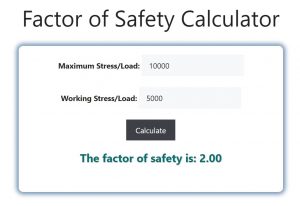About Factor of Safety Calculator (Formula)
The Factor of Safety (FoS) is a crucial concept in engineering, ensuring that structures and components can support loads safely beyond the expected limits. Our Factor of Safety Calculator simplifies the process of determining this important value, allowing engineers to ensure their designs meet safety standards.
Formula
The formula for calculating the Factor of Safety is:
FoS = Ultimate Load / Allowable Load
Where:
- Ultimate Load is the maximum load a structure or component can withstand.
- Allowable Load is the maximum load a structure or component is designed to handle under normal operating conditions.
How to Use
- Input the Ultimate Load: Enter the maximum load that the structure or component can handle before failure.
- Input the Allowable Load: Enter the maximum load the structure or component is expected to carry under normal conditions.
- Calculate the FoS: The calculator will divide the Ultimate Load by the Allowable Load to give you the Factor of Safety.
Example
Suppose an engineer is designing a beam that can handle an ultimate load of 10,000 N, and the allowable load is 5,000 N. Using the FoS formula:
FoS = 10,000 N / 5,000 N = 2
This means the beam has a Factor of Safety of 2, indicating it can handle twice the allowable load before failing.

FAQs
- What is a good Factor of Safety?
- A Factor of Safety between 1.5 and 3 is typically considered safe, depending on the application.
- Why is the Factor of Safety important?
- It ensures that a structure or component can withstand unexpected loads or conditions, reducing the risk of failure.
- How is the Ultimate Load determined?
- The Ultimate Load is usually determined through testing, calculations, or simulations based on material properties and design specifications.
- What happens if the Factor of Safety is too low?
- If the FoS is too low, the structure may fail under unexpected loads, leading to potential safety hazards.
- Can the Factor of Safety be too high?
- While a high FoS increases safety, it can also lead to over-engineering, resulting in higher costs and material usage.
- Is the Factor of Safety the same for all materials?
- No, the FoS can vary depending on the material’s properties and the application.
- Can the Factor of Safety be less than 1?
- An FoS less than 1 indicates that the structure is not safe and may fail under the expected load.
- How is the Allowable Load calculated?
- The Allowable Load is typically calculated based on the intended use, material strength, and design codes.
- What industries use the Factor of Safety?
- The FoS is used in various industries, including construction, automotive, aerospace, and manufacturing.
- Does the Factor of Safety account for environmental factors?
- The FoS may account for environmental factors like temperature, humidity, and corrosion if they impact the material’s strength.
- Can the Factor of Safety be applied to non-structural elements?
- Yes, the FoS can be applied to any component where safety under load is a concern, including mechanical parts and machinery.
- Is there a standard Factor of Safety for all applications?
- No, the required FoS varies by industry, material, and the specific application.
- How does the Factor of Safety relate to risk?
- A higher FoS reduces the risk of failure, providing a greater margin for unexpected loads or conditions.
- What is the difference between Ultimate Load and Allowable Load?
- The Ultimate Load is the maximum load before failure, while the Allowable Load is the maximum safe load under normal conditions.
- How often should the Factor of Safety be recalculated?
- The FoS should be recalculated whenever there are changes to the load conditions, material properties, or design specifications.
- What is a safety factor in terms of human safety?
- In human safety, a high FoS ensures that structures and devices are safe for use under expected and unexpected conditions.
- Does the Factor of Safety include a margin for error?
- Yes, the FoS provides a margin for error, accounting for uncertainties in material properties, load conditions, and design assumptions.
- Can software be used to calculate the Factor of Safety?
- Yes, various engineering software tools can calculate the FoS, often with more complex considerations than manual calculations.
- What is the role of engineering codes in determining the Factor of Safety?
- Engineering codes provide guidelines and standards for calculating the FoS, ensuring safety and consistency across projects.
- Can the Factor of Safety change over time?
- Yes, the FoS can change due to material degradation, wear and tear, or changes in load conditions, so regular assessment is important.
Conclusion
The Factor of Safety is a fundamental concept in engineering that helps ensure the reliability and safety of structures and components. By using our Factor of Safety Calculator, engineers can easily determine whether their designs meet the necessary safety standards, helping to prevent failures and ensure long-term durability.
